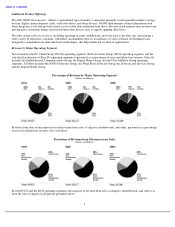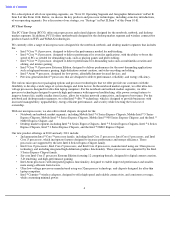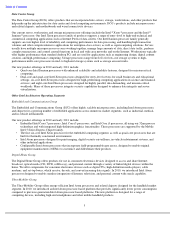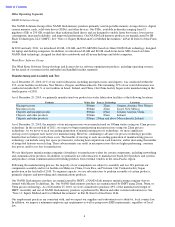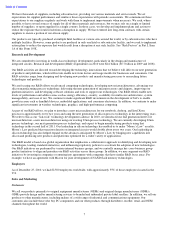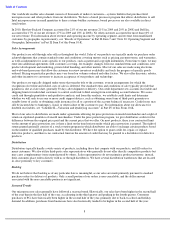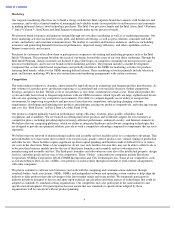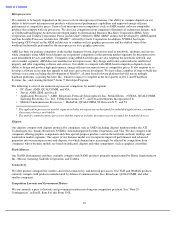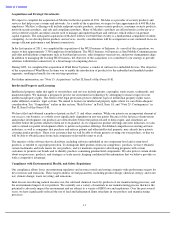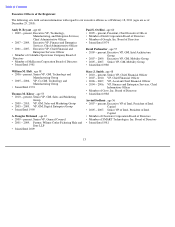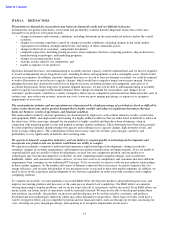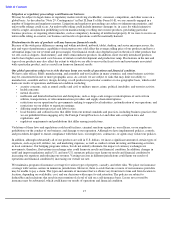Intel 2010 Annual Report Download - page 19
Download and view the complete annual report
Please find page 19 of the 2010 Intel annual report below. You can navigate through the pages in the report by either clicking on the pages listed below, or by using the keyword search tool below to find specific information within the annual report.
Table of Contents
Microprocessors
We continue to be largely dependent on the success of our microprocessor business. Our ability to compete depends on our
ability to deliver new microprocessor products with increased performance capabilities and improved energy-efficient
performance at competitive prices. Some of our microprocessor competitors, such as AMD, market software-compatible
products that compete with our processors. We also face competition from companies offering rival architecture designs, such
as Cell Broadband Engine Architecture developed jointly by International Business Machines Corporation (IBM), Sony
Corporation, and Toshiba Corporation; Power Architecture* offered by IBM; ARM* architecture developed by ARM Limited;
and Sun Scalable Processor Architecture (SPARC*) offered by Oracle Corporation. In addition, NVIDIA has begun
developing CPUs based on the ARM architecture to combine with its graphics processors and has shifted some of the
workload traditionally performed by the microprocessor to its graphics processor.
AMD has been our primary competitor in the market segments for microprocessors used in notebooks, desktops, and servers,
while companies using ARM-based designs are our primary competitors in the growing market segments for microprocessors
used in handheld devices and tablets. Companies using ARM-based designs are also targeting the notebook, netbook, and
server market segments. ARM does not manufacture microprocessors; they design and license semiconductor intellectual
property and offer supporting software and services. Our ability to compete with ARM-based competitors depends on our
ability to design and produce high-performance, energy-efficient microprocessors at competitive prices. It also requires us to
develop a software ecosystem that appeals to end users and software developers. We have taken a number of steps to build this
software ecosystem, including the development of MeeGo*, a Linux-based software platform that will run on multiple
hardware platforms; acquiring McAfee, Inc., which we expect to complete in the first quarter of 2011, and Wind River
Systems, Inc.; and creating the Intel
®
Atom
TM
Developer Program.
The following is a list of our main microprocessor competitors by market segment:
Chipsets
Our chipsets compete with chipsets produced by companies such as AMD (including chipsets marketed under the ATI
Technologies, Inc. brand), Broadcom, NVIDIA, Silicon Integrated Systems Corporation, and VIA. We also compete with
companies offering graphics components and other special-purpose products used in the notebook, netbook, desktop, and
workstation market segments. One aspect of our business model is to incorporate improved performance and advanced
properties into our microprocessors and chipsets, for which demand may increasingly be affected by competition from
companies whose business models are based on dedicated chipsets and other components, such as graphics controllers.
Flash Memory
Our NAND flash memory products currently compete with NAND products primarily manufactured by Hynix Semiconductor
Inc., Micron, Samsung, SanDisk Corporation, and Toshiba.
Connectivity
We offer products designed for wireless and wired connectivity, and network processors. Our WiFi and WiMAX products
currently compete with products manufactured by Atheros Communications, Inc., Broadcom, QUALCOMM, and other
smaller companies.
Competition Lawsuits and Government Matters
We are currently a party to lawsuits and government matters involving our competitive practices. See “Note 29:
Contingencies” in Part II, Item 8 of this Form 10-K.
10
•
PC Client: AMD, QUALCOMM, and VIA
•
Server: AMD, IBM, and Oracle
• Application Processors
1
: AMD, Broadcom, Freescale Semiconductor, Inc., MediaTek Inc., NVIDIA, QUALCOMM,
Samsung Electronics Co., Ltd., STMicroelectronics N.V., and Texas Instruments Incorporated (TI)
•
Mobile Communications Processors
2
: MediaTek, QUALCOMM, ST
-
Ericsson N.V., and TI
1
The application processors market segment includes microprocessors designed for embedded applications, consumer
electronics devices, and tablets.
2
The mobile communications processors market segment includes microprocessors designed for handheld devices.



